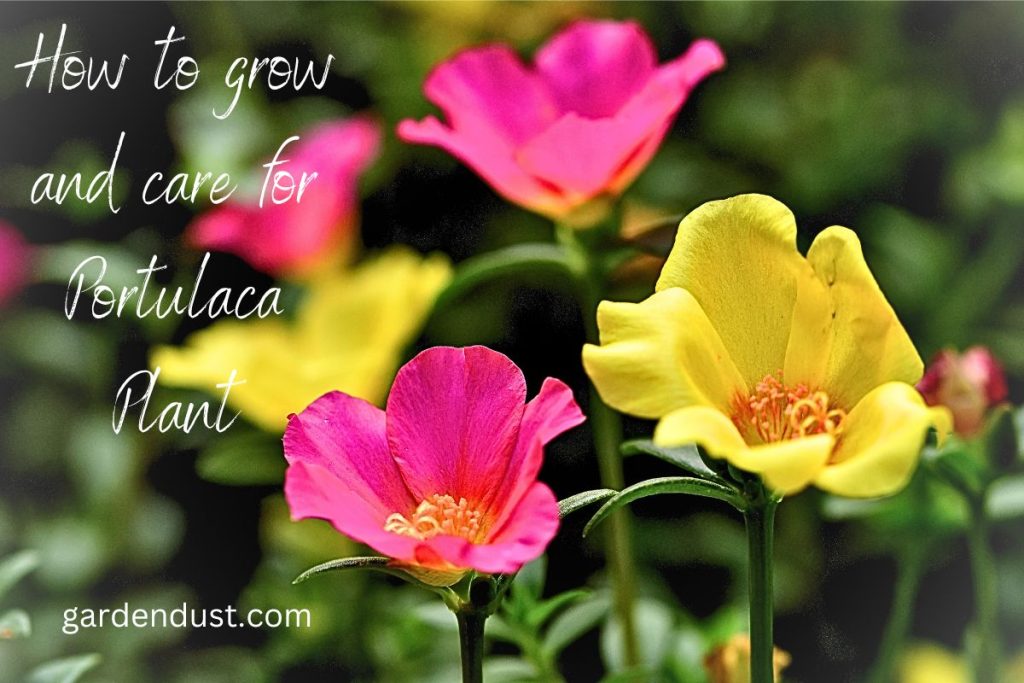Portulaca, also known as purslane or moss rose, is a flowering plant genus that includes over 100 species. It is native to tropical and warm temperate regions of the world, and is commonly found in gardens and as a weed in many parts of the world. In this article we will discuss detail about How to grow and care for portulaca plant. Lets start….
Portulaca plants have succulent leaves and stems, which allows them to store water and survive in dry conditions. The flowers of portulaca plants are typically brightly colored, and come in shades of pink, red, yellow, white, and orange. The flowers typically bloom in the summer months.
Portulaca plants are easy to grow and care for, and can be grown in containers or in the ground. They prefer well-drained soil and full sun, and do not require a lot of water. In fact, overwatering can cause the roots to rot. Portulaca plants are also relatively pest-resistant, although they may be susceptible to fungal diseases in humid conditions.
In addition to being grown as ornamental plants, some species of portulaca are used for medicinal purposes in traditional medicine. The leaves and stems of the plant are believed to have anti-inflammatory and diuretic properties, and may be used to treat a variety of conditions, including urinary tract infections and digestive issues.
Native and Botanical Name
Portulaca is the common name for the plants of the genus Portulaca. The genus Portulaca belongs to the family Portulacaceae, which includes about 100 species of plants.
The botanical name of the common purslane or garden purslane is Portulaca oleracea. The botanical name of the moss rose is Portulaca grandiflora. There are other species in the genus Portulaca as well, including Portulaca molokiniensis, Portulaca lutea, Portulaca suffruticosa, and Portulaca retusa, among others.
Colours of Portulaca
Portulaca plants are known for their brightly colored flowers, which come in a range of shades. Some common colors of Portulaca flowers include:
- Pink
- Red
- Yellow
- White
- Orange
- Magenta
- Purple
There are also many hybrid varieties of Portulaca that have been bred to produce flowers in unique and unusual colors, such as bi-color or multi-color flowers.
Grow And Care
Portulaca plants are easy to care for and maintain. Here are some tips for caring for Portulaca:
Soil:
Portulaca plants prefer well-draining soil, so make sure the soil you plant them in drains well. If your soil is heavy or clayey, consider mixing in sand or perlite to improve drainage.
Watering:
Portulaca plants are drought-tolerant, and do not require a lot of water. Overwatering can cause the roots to rot, so make sure to let the soil dry out between waterings. Water the plants deeply when you do water them, but allow the soil to dry out between waterings.
Sunlight:
Portulaca plants prefer full sun, and can tolerate hot and dry conditions. Make sure to plant them in a spot that gets at least 6 hours of direct sunlight per day.
Fertilizing:
Portulaca plants do not require a lot of fertilizer, but you can feed them with a balanced fertilizer once a month during the growing season to promote healthy growth and blooming.
Pruning:
Portulaca plants do not require a lot of pruning, but you can deadhead spent flowers to promote more blooming. You can also pinch back the tips of the stems to encourage bushier growth.
Pests and diseases:
Portulaca plants are relatively pest-resistant, but may be susceptible to fungal diseases in humid conditions. Make sure to plant them in a spot with good air circulation to prevent fungal diseases. You can also use an organic fungicide if you notice signs of fungal disease.
By following these tips, you can help your Portulaca plants thrive and produce beautiful flowers throughout the growing season.
Propagation
Portulaca plants can be easily propagated through stem cuttings or by collecting and planting seeds. Here are the steps for propagating Portulaca:
- Stem cuttings: Take stem cuttings from a healthy Portulaca plant during the growing season, when the plant is actively growing. Cut off a stem that is about 4-6 inches long, and remove the leaves from the bottom 2 inches of the stem. Dip the cut end of the stem in rooting hormone powder, and plant it in a pot filled with well-draining soil. Keep the soil moist but not waterlogged, and place the pot in a bright, warm spot. The cutting should root within a few weeks and can be transplanted to its permanent location.
- Seed propagation: Collect seeds from a mature Portulaca plant after the flowers have faded and the seed capsules have dried. Sow the seeds in a pot or directly in the ground in well-draining soil, and cover them lightly with soil. Water the soil and keep it moist but not waterlogged. The seeds should germinate within a week or two and will grow into mature plants over the course of the growing season.
Tips:-Propagation by stem cuttings is a faster method of propagation, while propagation by seeds takes longer but can produce a larger number of plants.
Common Disease And Pests
Portulaca plants are generally pest-resistant, but they may be susceptible to certain diseases and pests under certain conditions. Here are some common diseases and pests of Portulaca:
- Fungal diseases: Portulaca plants may be susceptible to fungal diseases such as powdery mildew and leaf spot. These diseases can be prevented by ensuring good air circulation around the plants and avoiding overhead watering. You can also use an organic fungicide if necessary.
- Aphids: Aphids are small, soft-bodied insects that can suck the sap from Portulaca plants, causing distorted growth and yellowing leaves. They can be controlled with insecticidal soap or neem oil.
- Spider mites: Spider mites are tiny insects that can cause yellowing leaves and webbing on Portulaca plants. They can be controlled with insecticidal soap or neem oil.
- Slugs and snails: Slugs and snails can eat holes in the leaves of Portulaca plants, particularly in damp conditions. You can control them by handpicking or using a slug and snail bait.
To prevent disease and pest problems with Portulaca plants, make sure to provide good growing conditions such as well-draining soil, full sun, and good air circulation. Regularly inspect your plants for signs of pests or disease, and take action promptly if you notice any problems. Happy Gardening…







